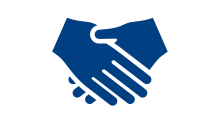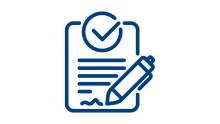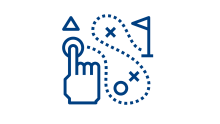Let's Get To Know Each Other

Step 1: Intro Discovery Call
The first step in our process is a short 30-minute phone call to learn more about each other. This is a complimentary meeting. There are no pre-requisites to this consultation. We view this meeting as more of an informal "get to know you meeting" where we'll learn very quickly what you're working on and if we can help. While we won't get too deep, this call helps us both decide if our services are in line with the type of help you're looking for. If they're not, often we can still point you in the right direction.

Step 2: Formal Initial Meeting
If it seems like there is basis for a relationship, we then look to dive deeper into our process and advice by starting to answer more specific questions and asking for more details from you. This is still a complimentary meeting, but a bigger investment of time for us both as this meeting typically lasts 60-90 minutes.
While not a pre-requisite, we do encourage that you share some financial data in this meeting so we can speak more specifically to the advice we would explore together.
Goals for you
This is an opportunity to do two things:
1. Share your fires (what you're focused on that led you to schedule the first meeting with us)
2. Get to know us. Since financial planning with us is a very personal relationship, you'll want to know that we're both technically sound in the way we give advice, but also the right personality and communication fit for you.
Goals for us
Since our process is centered on you and your goals, it's really important to us that we learn about what matters most to you, how you think and feel about money, and where you are on your journey through life. So, we'll ask a lot of questions in this meeting. We want to get to know you as a person to see if/how we can help. This meeting is an important first step in seeing how we communicate with you, and what the priorities will be.

Step 3: Data Gathering
This step requires you to share some specific documentation with us: our data gathering checklist. We invite you into a custom, personalized and secure "vault" through our planning software called "eMoney". If we choose to work together, this data aggregation and client facing software acts as our relationship hub, a place for you to always see what's happening in your financial life, and a place where we share and store important documents. If you're not comfortable using this technology, you're welcome to share paper statements as well. While eMoney allows you to link accounts, there is a separate checklist that we provide of "good to know" information such as tax returns, paystubs, estate documents, and cash flow analysis. We want this list to be a guide for you so that we can begin to know your financial situation as soon as possible.
From there, we do some work behind the scenes. As a team, we work through your financial data, and in combination with all our meeting notes, start to assess what's going well, what is not, what are your goals, and how can we help you get there.

Step 4: Observations & Proposal
If we both feel like we're a good fit for each other, we offer to draft a formal financial planning proposal for you where we assess and recommend one of our planning models (Initial Financial Planning or Subscription-Based Planning). The proposal consists of 4-6 pages and lists the questions we propose to answer for you through our planning work and outline the deliverables you will receive at the end of the planning process. The proposal will be tailored specifically to you. More often than not, we wish to see all new relationships go through our Initial Financial Planning Process, which covers what we deem to be the fundamentals of a financial life (cash flow, cash reserve, debt management, insurance, tax reviews, investments and estate planning), as well as, the goal-orientation that we highlight specifically for you in our formal proposal (examples: asset accumulation, retirement planning, estate planning, charitable giving, college planning, etc.). It's the combination of covering the planning fundamentals and the goal-planning projects that determine the appropriate fee for our advice.
All of this work culminates in proposing a relationship, with a specific fee that will be paid at signing. At this point, it's your decision whether you wish to work with us or not. If you feel our proposal is appropriate, we ask you to review our Financial Planning Agreement and appropriate disclosures associated with our work. This can be done electronically, or if requested, through a printed form. Or feel free to take your time and sleep on it and let us know when you're ready.
*NOTE* all our advice is reviewed and signed off on by our compliance team at Great Vally Advisor Group, a protection for you (the client), which is why checks are never made payable directly to the Haas Financial Group.
You've decided you want to work with us. What's next?

Onboarding Meeting
We utilize our onboarding meeting to get our relationship off on the right foot! We want to be sure we introduce the whole team, explain our partnerships, and use our time together to check the administrative boxes too. Then we'll do some additional intake to confirm your core values and beliefs, understand your feelings on risk and return, and see what you're looking forward to. We'll capture the important people, places, and things in your life. We'll take a thorough financial inventory of everything you own, what you owe, and your current and future income. Then we use all this information to start answering your key questions and plotting out a plan of action with your unique needs and goals in mind. By the end of the meeting, you’ll be plugged into our technology and planning tools to the extent that you wish to be connected, and we’ll have identified the most effective method(s) of communicating together throughout our relationship.

Evaluating The Possibilities
This is where education and plan development come in. Here we focus on the process, the actual planning, and take the time to really think about our resources, our goals, our values, our opportunities and threats that formulate insights, strategies, and further information. We explain where you’re at today, and how that connects to the goals we identified in our initial discussions. We explain your options and evaluate the tradeoffs of various decisions. Then we agree on a way forward, knowing that the decisions we’re making now are never permanent. Through all complex transitions, we encourage you to remain open to change. It’s important to create a flexible plan. However, walking through a plan helps prioritize and crystallize our decisions on what to do, or what not to do.
Check out our example client profiles here

Plan Delivery & Putting Your Plan Into Action
This is where implementation happens as we get your financial life organized. Whether the planning document is 8 pages long or 18 pages long, the personalized report documents what we observed, what we recommend and what the next steps are, to be completed by whom, and by when. This table (Next Steps, By Whom, By When) is a staple of our business and all our meeting notes, as it hold us all accountable and organized to our work together. The action items will be ongoing - recognizing they will be done over time as they more to the top of your priority list. We don't want to overwhelm you, so we take small steps to ensure we're partnering to make good decisions for the present, and future. Our goal is to work through this initial plan within the first 6-12 months of working together.

Subscription-Based Planning (ongoing planning)
We look at every new relationship as a long-term relationship. After the design and implementation of your plan is complete, we'll continue to meet at least two times per year. Life is constantly changing and while a lot of work is typically done within the first 12 months of drafting a financial plan, we can't stop once the plan is initially completed. We utilize our seasonal planning model to track ongoing progress and expect that you keep us updated on any life changes relevant to your plan, and we of course do the same. We also realize that planning is an ongoing process with surprises along the way. If you chose to work with us on an ongoing basis, we will provide a formal proposal based on our time dedicated to meetings, complexity of your situation, and effort required. This fee could be paid on a monthly or quarterly basis.
Investing with the Haas Financial Group
The appropriate investment allocation for someone should be the byproduct of two key conversations:
- What does the financial plan say is an appropriate allocation for risk and growth potential?
- How does that person feel about investment risk?
That's why investing with the Haas Financial Group only occurs after going through a financial planning process. It's that process that allows us to confidentially recommend an investment plan based on what we need to manage for you, your time horizon, your liquidity needs, and your appetite for risk.
Our approach to building investment plans is very fundamental. We believe the practice of spreading investment around and creating exposure to different types of asset classes can help reduce volatility over time. We also believe that markets can be irrational at times, because as humans, we are irrational at times. There are many factors that can move the markets, making it difficult, if not impossible to predetermine when to specifically buy or sell any one investment with any degree of precision. Hence, we believe you manage risk via asset allocation and diversification, not via timing trading. In summary, build an investment plan that matches your financial plan, diversify, tweak as necessary and adjust as goals and priorities change.

